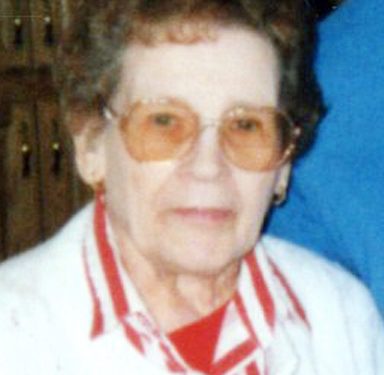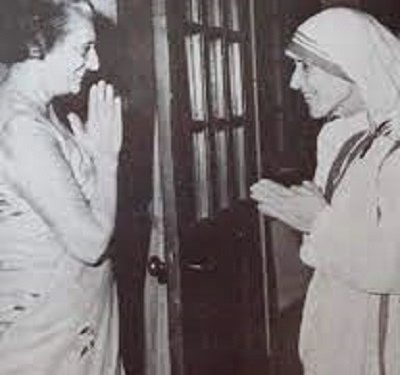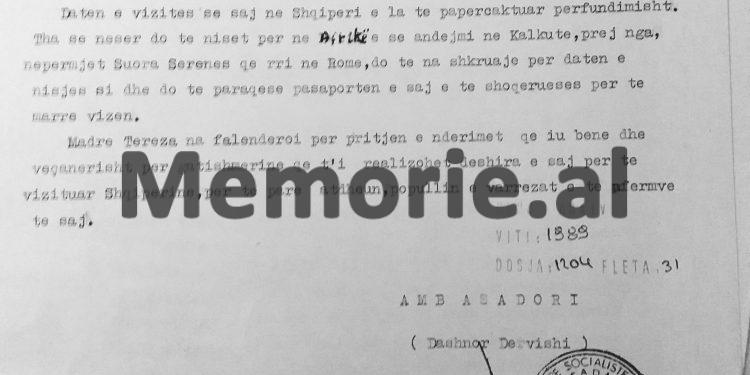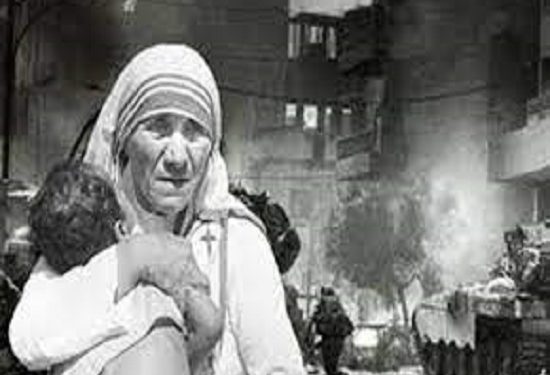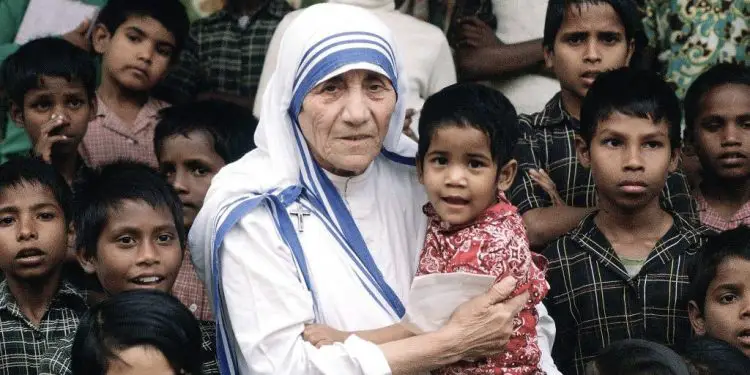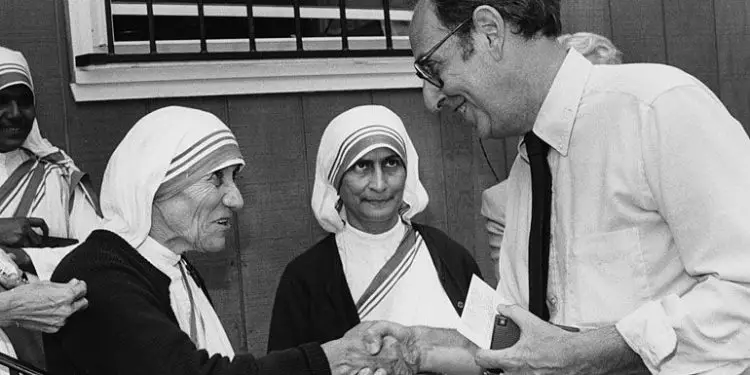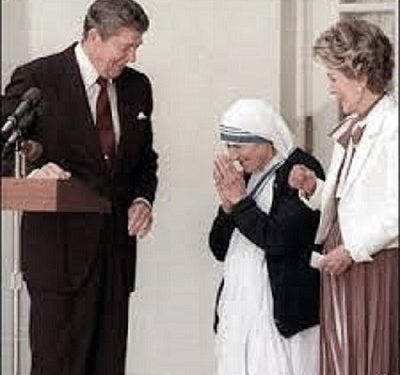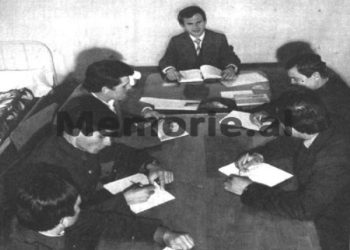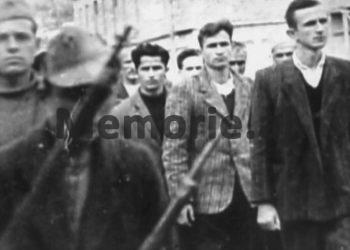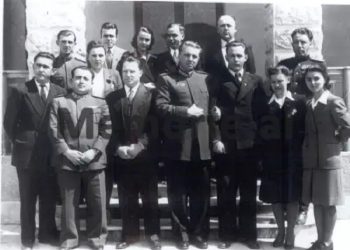Dashnor Kaloçi
The third part
Memorie.al publishes some archival documents with the logo “Top secret” recently released from the Archive of the Ministry of Foreign Affairs in Tirana and the Central State Archive, which belong to a period of time from (1969-1991), where there is a correspondence between the Ministry of Foreign Affairs with the Central Committee of the ALP and some Albanian diplomatic missions accredited in the West, such as Rome, Paris, etc., with telegrams, reports, information, orders, diplomatic notes, invitations, articles, newspapers, press leaflets, photographs, etc., where it is about Mother Teresa of Calcutta, the famous saint of Albanian origin, Gonxhe Bojaxhi, winner of the Nobel Peace Prize in 1979, which since 1969, through French channels and Italian Diplomats , I asked official Tirana to come to Albania, to her homeland, to visit her mother, Roza Bojaxhi, who at that time was 86 years old and ill, as well as her sister, Age, who lived in Tirana. All the complete documentation is made public for the first time by Memorie.al, where light is shed on all the charitable activity of the famous saint, to help the poor around the world and her extraordinary desire to help her compatriots in Albania. communist rule, as well as the total silence of official Tirana and the high communist leadership of that time, led by Ramiz Alia and Nexhmije Hoxha, who under various pretexts prevented her arrival in Albania and allowed it only in 1989, thanks to pressure great international!
Continues from the previous number
Report of the Albanian Ambassador to Rome, Dashnor Dervishi, sent to the Ministry of Foreign Affairs in Tirana, regarding the visit of Mother Teresa to that embassy, on July 7, 1989
R. P. S. SH.
MINISTRY OF FOREIGN AFFAIRS
ROME EMBASSY
Rome, 7 July 1989
Subject: Information on the meeting with Mother Teresa at our Embassy in Rome
MINISTRY OF FOREIGN AFFAIRS
(First Directorate)
Tirana
Today at 11.00 Mother Teresa came to our embassy accompanied by two nuns. One also served as a translator, as she did not know Albanian.
From the beginning of the conversation, Mother Teresa said that she wants to go to Albania to see the grave of her mother and sister. She said she has a home, but did not know where it was and if it still existed. She said that since she had no relatives to meet, she left it to the desire of the hosts to arrange a visit to our country.
She further added that she would like to visit Korça, Shkodra and any other place similar to the city where she was born (Skopje). In these places she wants to visit a hospital, orphanage, asylum and the graves of her relatives in Tirana.
The time of her private trip to Albania will be the first week of November, so that on November 13, she will return from Albania to Italy, where she will give a speech at the International Conference dedicated to AIDS.
She asked about the state of religion in Albania, if there were churches where she could pray, or any priest who could perform religious services, during the days she would be in Albania. After we spoke about the state of religion in Albania, Madre Tereza did not insist on the above, and agreed to come with a suore from Prizren, but who now serves in Europe in one of the missions of her charity.
However, she hinted that she hopes that in the future, as in 70 countries around the world (including the USSR) and in Albania, she can create a center where she can leave some of her souls for charity.
She was asked if she had any special requests for the visit she would make. She said she would like to stay in a secluded hotel or house, without fuss or publicity, eating and drinking cold things and mostly alone.
The date of her visit to Albania has remained undetermined. She said that tomorrow she will leave for Africa and from there to Calcutta; from where she will stay in Rome, she will write us the departure date and will send us her and her companion passport, to get the visa.
Mother Teresa thanked us for the reception and honors given to her and especially for the readiness that is being shown for her visit to Albania, to see the graves of relatives.
Ambassador
(Dashnor Dervishi)
Report of Ambassador Dashnor Dervishi from Rome, to the Minister of Foreign Affairs, Reiz Malile, regarding the request of the filmmaker of Canadian origin who sought to accompany Mother Teresa during her visit to Albania
R. P .S. SH.
MINISTRY OF FOREIGN AFFAIRS
ROME EMBASSY
Rome, 8.8.1989
FOREIGN MINISTRY
(Comrade REIZ MALILE)
TIRANA
This morning, the Canadian filmmaker, Jeanette Petrie, of Canadian origin and resident in New York, appeared at the embassy. She was accompanied by two suras of Mother Teresa. After submitting a videotape about her life and activity, she asked to accompany him during her visit to Albania.
Since it was equipped with an American passport, we told her the difficulties that arise in this regard. She prayed that her request would be viewed positively, as she accompanied Mother Teresa on every visit. Said he has Canadian citizenship and issues Canadian passport, will come again on Friday.
Please let us know if you have any special orders for it.
Dashnor Dervishi
Articles of the newspaper “Zeri i Popullit” and the Albanian Telegraphic Agency on August 15, 1989, regarding the visit to Albania of the well-known charity, Mother Teresa
“Voice of the People” 15.8.1989
Arrived in Tirana for a private visit, Mother Teresa.
The well-known Albanian charity, winner of the Nobel Peace Prize, Mother Teresa (Gonxhe Bojaxhiu) has arrived in Tirana for a private visit.
She came to Albania with the great desire and longing to see her country, as well as to pay homage to the graves of her family in Tirana.
Mother Teresa was born in Skopje in 1910 to Albanian parents. After school, she worked for several years as a teacher in Calcutta, India. She later devoted herself entirely to her charitable work for the benefit of the sick, the poor, the abandoned, the victims of war and natural disasters in India as well as in many parts of the world.
For her selfless activity and full of sacrifices, she has been honored with high awards by various countries and international organizations. In 1979 she was awarded the Nobel Peace Prize.
At the airport she was received by the Chairman of the Albanian Red Cross, Ciril Pistoli, and the Chairman of the Albanian Committee for Cultural Relations with the World, Jorgo Melica, and others.
ATSH
MOTHER THERESA: I join the pain and misery of your people
Mother Teresa is widely known as one of the founding leaders of the Order of Charity. We remind readers that in August 1987 this tireless woman visited the USSR for the first time at the invitation of the Soviet Committee for the Defense of Peace and the Russian Orthodox Church. She went to the regions damaged by the crash at the Chernobyl nuclear power plant.
“I join the misery and pain of your people,” Mother Teresa told Izvestia newspaper. “After learning about the terrible earthquake in Armenia, I felt a deep despair. I had a desire that I could not overcome, to go to the Soviet Union. I, prayed for the salvation of the people. In the activity of our order, the main thing is to provide assistance with concrete actions, especially care for the sick and injured.
Charitable nuns are always at the service of those who suffer. Wherever tragedy occurs on earth, we must be there and help unselfishly. I hope that after me this issue can be discussed because, will come the doctors and nurses nuns of the order of our charity. They will bring with them warmth and spiritual love. People need love more than bread. However we will also help with food.
In addition to her visit to Armenia, Mother Teresa will hold talks these days and sign an agreement with the Soviet Committee for the Protection of Peace, for the unpaid work of her nun sisters in the USSR. The approval in principle of the USSR Ministry of Health regarding their work has already been obtained, for example in the pan-Soviet center for spinal and head traumas.
Mother Teresa responded to the call to work personally to help the victims of the earthquake in Armenia. She has expressed the desire to work during the visit in one of the hospitals in Moscow where the wounded were hospitalized from Armenia. She calls it her duty to help and care for them in the future.
(Taken from the newspaper “Izvestia” dated 17 December 1988)
Writing of the Soviet newspaper “PRAVDA”, regarding the visit of Mother Teresa to Albania on December 18, 1989
PEOPLE NEED CHARITY
One of the founders and head nuns of the charity order arrived in Moscow.
Mother Teresa arrived in the USSR at the invitation of the Soviet Committee for the Protection of Peace, in connection with the earthquake in Armenia and the signing of an unpaid employment contract in one of the Moscow hospitals of the four nuns of the Order of Charity.
Mother Teresa (Anjezë Gonxhe Bojaxhiu) is a nun of the Roman Catholic Church in India. With the help of this order, schools for the poor, orphanages, asylums, etc. have been set up. The order activity extends to 87 countries. In 1979, Mother Teresa was awarded the Nobel Peace Prize for her work in helping people in need. She is a doctor of Theological Sciences. Last year Mother Teresa was awarded the gold Medal of Honor “Warrior of Peace” by the Soviet Committee for the Defense of Peace.
“Respect and love for man, there is nothing more wonderful,” she said. “We must not forget those who suffer and who are sick. Man’s love for man, is expressed in our view, in small but active actions, wound dressing, adjusting the pillow of the sick, feeding a hungry family, etc. one word this is love expressed in action. This is the opinion of all the nuns of our order who work in dozens of countries of the world. People need not charitable declarations but good deeds “…
The first talks on signing the agreement took place in the Peace Defense Committee. Mother Teresa expressed the desire to work two days in one of the hospitals of the capital. Today, the guest, together with her two assistants, leaves for Armenia, to express her condolences and sympathy to the people affected by the disaster.
ATSH
(Taken from the newspaper “Pravda” dated December 18, 1989)
The article in the Yugoslav magazine “Novoje Vremja” about Mother Teresa on September 4, 1987, which contains a long biography of her
MOTHER THERESA: LOVE SAVES THE WORLD
The word “charity” has disappeared so much from our lexicon that in its very sound there is something archaic. Rushing towards the cosmos, recognizing the universe in its macro and micro levels, being reminded of our achievements, we have left the universe in the background inside us. We have forgotten that not only the brain and hand, but also the human soul is also the result of a long process of evolution. Gradually, initially shyly, we include simple human feelings in the category of unnecessarily free “sentiments”, they could adversely influence rational decisions, whether personal or state.
The strongly entrenched idea that the socialist homeland has a duty to take care of every member of it from birth to death in interaction with moral laziness, gives rise to exactly that social inertia that has been created by the current problems of perestroika.
How strong is the desire in us to overcome within ourselves the cursed laziness in the face of injustice or misfortune, and how strongly does the expression still hold us to justify with a saving saying “And what do I have in my hand?” or “Who’s entitled to do it.”
I started it from charity that opposes indifference and social inertia. The occasion was the arrival of Mother Teresa in our country and the conversation with her, short, but to introduce you to deep thoughts on many things.
Who is this mother Teresa?
She is the head none of the Order of Charity founded by her. Doctor of Theology, winner of the Nobel Peace Prize in 1979 for “Activities in aid of suffering humanity”.
You are shocked when you see her for the first time – how weak and small this old woman with the face of a blackened peasant and full of wrinkles! Had she not worn the white Indian saree with blue fringe, the dress of the nuns of the Order of Charity, she is no different from our grandparents, who find them standing in front of our long-haul buses, through the streets of filled with village dust: between the legs full bags, hands resting heavily on the knees.
What hands Mother Teresa has – big considering her height, which has seen a lot of work, inflated! Is that how the theologians, the Nobel laureates, have their hands full? She laughs in response – she laughs happily, honestly. Are nuns allowed to laugh? Shouldn’t they walk with their eyes down playing with rosaries all the time? The carpets are actually in her hands…
“We do everything with our hands,” she says. “Let it be the most modest help, but given with great love. Even a simple smile, because it is a sign of love for man. The outstretched hand because it is a symbol of love.
People need love, everyone wants to love and to be loved wants to know that someone needs him, that he can call someone his own and today we do not even have time to see the other; for this reason a loving smile is a great gift, sympathy- an invaluable gift.
She tells a story she likes to repeat often: on a London street she saw a grim man and after approaching him, grabbed his hand. “He had a cold hand,” says Mother Teresa. “He was shocked and said, ‘I have not had time to feel human warmth.’
Mother Teresa speaks of the simplest things and in the simplest words; she is entitled to this unlimited simplicity. The great truths are simple to the point of banality. But the tendency towards them is not banal.
Mother Teresa was born in 1910 in Skopje to an Albanian family. Her birth name is Anjeze Gonxhe Bojaxhiu. She speaks Serbian as her mother tongue and understands Russian quite well. The Balkan Wars, and then World War I, moved her hometown to another country, spreading her family around the world. Anjeza was found in Ireland. As a young woman, she entered the Catholic order “Irish Sisters Loreto”. In 1929 she went to India as Sister Teresa and began teaching geography at the missionary school for girls.
But her true charity mission began in the hell of Calcutta slums, first alone, then with the help of her students, who later became nuns of the Order of Charity. Mother Teresa gathered in the streets people who inspired not only hope but also despair.
It first provided shelter for the dead, then for orphans and abandoned children, as well as hospitals and schools. There are now 2,800 Charity Order nuns working in 77 countries around the world. There is such a custom in India: people with Great Spirit come to see people, even from afar. This is called “Darshan” – scrutiny. It is thought that one who observes, even a little, ultimately benefits from that person’s spiritual qualities.
I tried something similar to “Darshan” when I saw the documentary “Mother Teresa”. I saw Mother Teresa’s hands massively and for a long time massaging the breast of a child, pulled out of besieged Beirut, and her face distorted by a horrible grimace began to soften, while in the dark eyes an expression of awareness…!
The scenes follow one another, in drought-stricken Ethiopia, in post-earthquake Guatemala, in the hell of American slums, again in bombed-out Beirut, where Mother Teresa miraculously gathered and rescued 60 crippled and sick children. One after another, cars with small but also large Red Cross flags pass – so that no one can open fire by mistake. And there Mother Teresa, whom you did not know: she looked bigger in size, gave orders, which were immediately implemented by volunteer helpers to load the children in the cars as soon as possible!
“I am very grateful for this wonderful gift,” Mother Teresa told a news conference; “For the invitation to visit BS. I have been dreaming about this visit for many years and here today, thank God, I am here among you. God created man for a purpose – to love and be loved. There are many hungry, very homeless people in the world today, hunger is not only for a morsel of bread, but also for warmth and petting, while the lack of shelter over your head is also a feeling that you are unnecessary and abandoned. As terrible as the famine was in Ethiopia, we shared food there and managed to save many lives. But how can you erase the suffering of the lonely, the unwanted, the deprived, the sick with leprosy, or with the terrible new disease AIDS, of all those whom society has thrown away as unnecessary. Here is today’s hunger. We and you have a duty to be charitable to these people. You may not aim for great deeds, even small ones are enough, but with heart and love.
I have gone to villages where people who had been affected by the Chernobyl accident and who had been forced to leave their homelands had settled. I was happy to see how carefully and attentively they were surrounded. They told me how in that terrible disaster everyone rushed to their aid. “It’s wonderful the love that people bring to help in times of disaster.”
Listening to Mother Teresa’s words, simple and sincere, I also remembered Chernobyl, which unfortunately hit Georgia last winter, those situations when, as soon as it was called for help, people from all over the country offered help, money and warm clothes. . Maybe we need charity. We need to do more good and necessary deeds, work by putting our whole soul in service. To pave the way for the high feeling of sympathy not through the various bureaucratic avenues, but as our hearts ask us, the centuries-old traditions of charity for the good of man, that is, for the good of our society. We must not forget that charity helps both those who need it and those who give in pure spirit.
We all rejoiced at the creation of the Soviet Lenin Children’s Fund. Why not think about setting up a charity fund whose members go one or two hours a week to help in hospitals, asylums, orphanages, visit the lonely and the sick? Imagine how many happy people would do that. Mother Teresa is quite right to love is happiness.
- “Love cannot be limited to your country or any other place, we are all connected to each other, we belong to each other and we have a duty to help each other. “Here lies the meaning of the war for peace, and humanity has never needed peace as much as it does now,” said Mother Teresa.
She calls India her second home while humanity her family. For Mother Teresa this is not a phrase – sensational phrases do not irritate her mouth – this is her credo confirmed by work throughout her life. She who has seen so much suffering and pain addresses journalists:
“You should try to write about the beauty of life, to bring joy, love and hope to people, because man is born to live in joy and peace. “Peace at home and peace in the world.” It is difficult to convey the strength of Mother Teresa’s belief that love will save the world. As she says: we, perhaps, needless bread of the mouth than love, charity and mercy. Memorie.al
(Taken from the magazine “Novoje Vremja”, dated September 4, 1987, written by Marjam Sallganik).
The next issue follows




